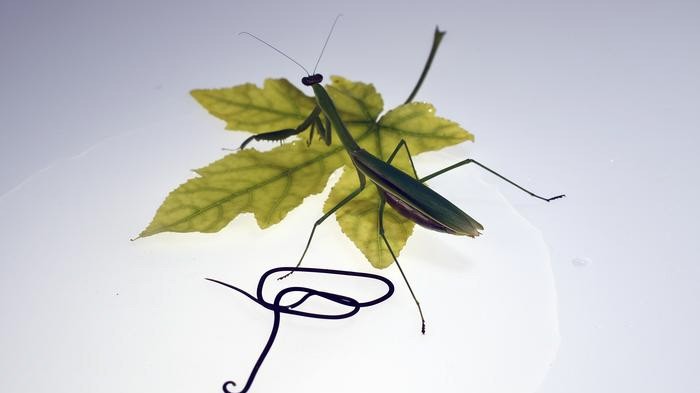He exploits others all his life: as a larva, he comes to land hitching a ride on aquatic insects. There he waits until a praying mantis eats him. It nests in it, feeds on its host, grows inside him, finally takes control of the host’s brain and forces him to jump into the water: the praying mantis falls. Because she dies, the parasite lives on. He needs the water to mate and reproduce. The cycle begins again.
We are talking about the horsehair worm, a whitish, brownish-golden shiny or black string worm, about as thin as spaghetti and usually of a similar length. A team led by biologist Takuya Sato from Kyoto University in Japan has now discovered how the parasite brainwashes its hosts: The worm steals genes from the praying mantis in order to manipulate it in a deadly way so that it throws itself into the water. The study appeared in science magazine Current Biology.
Previous studies have suggested that horsehair worms infiltrate the brains of their hosts by copying, in ways that were not fully understood, praying mantis biomolecules that the insects themselves use to navigate by light. The worms abuse these signaling molecules to urge their hosts towards the light and thus towards the often sparkling water. Exactly how they got these biomolecules remained a mystery.
Many living beings use gene transfer to quickly adapt to new conditions
Now the researchers led by Takuya Sato have discovered how the parasite brainwashes the praying mantis. When the worms manipulate the insect, around 3,000 genes work in them that are not active in worms that do not attack a host. These genes partly influence how signals are transmitted in nerve cells or how a living being reacts to light. The new study shows that the worms produce the manipulative biomolecules themselves, instead of getting the praying mantises to produce these molecules, as is known from viruses.
Around a thousand of the 3,000 activated genes almost completely match the genes of praying mantises – and they are apparently stolen. “Many of the horsehair worms’ genes that could play an important role in manipulating their hosts were very similar to the praying mantis genes,” says Tappei Mishina, co-author of the study. The scientist concludes “that they were acquired through horizontal gene transfer.”
Horizontal gene transfer is a process in which genes are transferred from one organism to another without reproduction. Living beings use the mechanism to quickly obtain new genes that make them better adapted to their environment. This is well known with bacteria: they develop the ability to become resistant to antibiotics. The horsehair worm uses horizontal gene transfer to increase its reproductive success: its larvae can only reproduce when the praying mantises plunge into the water.
The parasite is not alone with its manipulative behavior: a fluke, for example, attacks snails and turns them into zombies. He makes her antennae swell and pulsate in color. His goal: He wants to attract a bird that mistakes the snail for a caterpillar, be eaten by it and then reproduce in its intestines. Another example: A parasitic fungus attacks the nervous system of ants, causing them to climb into treetops. Once at the top, it grows out of them and lets its spores rain down. Parasites such as mosquitoes, ticks and worms do not stop at humans either. They also use it to reproduce. But so far there are no examples in which parasites manipulate people’s behavior or even turn them into zombies, such as in the TV series “The Last of Us”.

